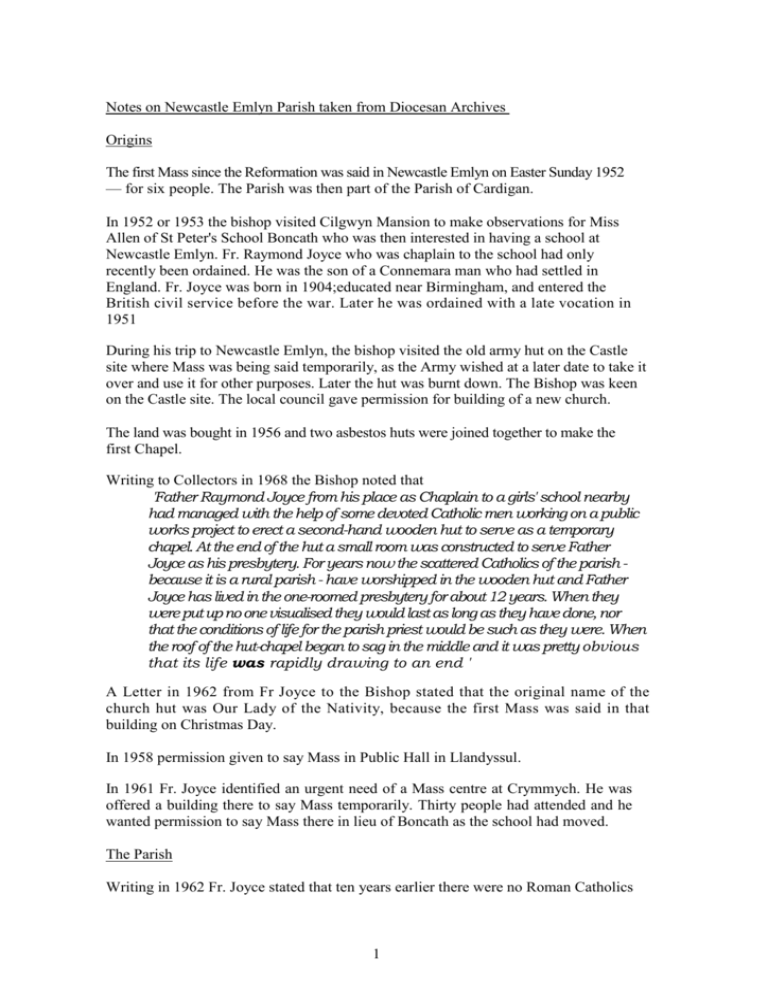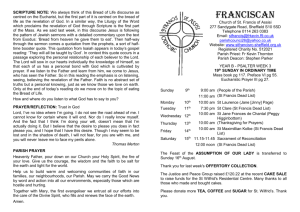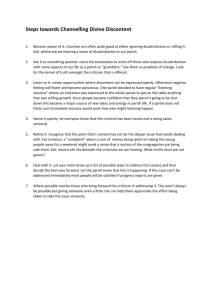Father Raymond Joyce
advertisement

Notes on Newcastle Emlyn Parish taken from Diocesan Archives Origins The first Mass since the Reformation was said in Newcastle Emlyn on Easter Sunday 1952 — for six people. The Parish was then part of the Parish of Cardigan. In 1952 or 1953 the bishop visited Cilgwyn Mansion to make observations for Miss Allen of St Peter's School Boncath who was then interested in having a school at Newcastle Emlyn. Fr. Raymond Joyce who was chaplain to the school had only recently been ordained. He was the son of a Connemara man who had settled in England. Fr. Joyce was born in 1904;educated near Birmingham, and entered the British civil service before the war. Later he was ordained with a late vocation in 1951 During his trip to Newcastle Emlyn, the bishop visited the old army hut on the Castle site where Mass was being said temporarily, as the Army wished at a later date to take it over and use it for other purposes. Later the hut was burnt down. The Bishop was keen on the Castle site. The local council gave permission for building of a new church. The land was bought in 1956 and two asbestos huts were joined together to make the first Chapel. Writing to Collectors in 1968 the Bishop noted that 'Father Raymond Joyce from his place as Chaplain to a girls' school nearby had managed with the help of some devoted Catholic men working on a public works project to erect a second-hand wooden hut to serve as a temporary chapel. At the end of the hut a small room was constructed to serve Father Joyce as his presbytery. For years now the scattered Catholics of the parish because it is a rural parish - have worshipped in the wooden hut and Father Joyce has lived in the one-roomed presbytery for about 12 years. When they were put up no one visualised they would last as long as they have done, nor that the conditions of life for the parish priest would be such as they were. When the roof of the hut-chapel began to sag in the middle and it was pretty obvious that its life was rapidly drawing to an end ' A Letter in 1962 from Fr Joyce to the Bishop stated that the original name of the church hut was Our Lady of the Nativity, because the first Mass was said in that building on Christmas Day. In 1958 permission given to say Mass in Public Hall in Llandyssul. In 1961 Fr. Joyce identified an urgent need of a Mass centre at Crymmych. He was offered a building there to say Mass temporarily. Thirty people had attended and he wanted permission to say Mass there in lieu of Boncath as the school had moved. The Parish Writing in 1962 Fr. Joyce stated that ten years earlier there were no Roman Catholics 1 in the Newcastle Emlyn district. It was a non-conformist stronghold. He added that a hard and bitter struggle began, on which, on three public occasions the priest was asked to leave the town. On the last occasion the squire, Captain FitzWilliams, successfully intervened and used his influence to stop the open bigotry, and so allow the priest to provide facilities for Catholics to practice their Faith in the town. Fr Joyce observed that since those earlier days 'times have changed and there is now peace and friendliness towards the priest and Catholics and there has grown up a very strong nucleus of Catholics'. Writing to Fr. Annwyll, parish priest of Cardigan, in September 1956 Bishop Petit stated that 'I have further thought of dividing Cardigan Parish, making a new centre at Newcastle Emlyn. ' However, it was not until 1960 that Newcastle Emlyn became an independent parish, the first Parish Priest being Fr. Raymond Joyce. It took in part of three counties and extended over an area of 400 sq. miles, but had only 235 parishioners. When writing to potential benefactors Bishop Petit pointed to the missionary nature of the Diocese of Menevia. Mgr Hannigan described Newcastle Emlyn in 1964 as a mainly agricultural area, with a Catholic community comprising mainly agricultural workers – Welsh, Irish, Italian and Poles. In 1965 the congregation was said to be something over one hundred people. A few years later Fr David wrote in a leaflet: `Apart from visitors the Church serves 68 families: 22 Italian, 18 English, 10 Irish, 9 Welsh, 6 Polish, 2 Scots and one Hungarian lady — altogether 127 adults and 88 children. All but a handful live on farms or smallholdings scattered over 400 square miles of countryside in three counties. Instructing children is our greatest problem Of the 76 children of school age 47 are in 18 different primary schools and 29 in four different secondary schools. In the past many such children, too far from a Church, lost touch with the faith. Today, better roads and cars make it possible to collect them together from a wide area. The house is crammed on a Saturday. There are more in the Church and the Hut. ' Our Lady Queen of Peace Bishop Petit had been approached by Dr Constance Myatt of Birmingham, who wished to support a new church provided it would be dedicated to Our Lady Queen of Peace. He contacted Fr. Joyce who had plans for a church, school and Presbytery at Newcastle Emlyn, and also with church buildings at Crymych and Llandyssul. Fr Joyce happily agreed to a new church with a dedication to Our Lady Queen of Peace. In 1962 the bishop recorded that he had in mind to plan the church as a cruciform shape, the nave to be built as soon as possible and the arms to be added when money was made available. The architects selected were Weightman and Bullen of Liverpool. Bishop Petit envisaged something on the lines of the church they had designed for Welshpool; the nave to be built first then one transept – the transept to be used for sacristies. Joyce 2 wasn't too happy with the proposals wishing to have 'a more delicate construction for the church, to be more in keeping with the beautiful surroundings'. There would be some delay before the architects were re-commissioned. In June 1965 the Bishop asked the architects to build a church to seat about 100. Initial thoughts were that between £12,000 and £15,000 would be needed. The contract price for the new Church, exclusive of professional fees was L18,909.15.8. At the same time work was underway to recondition a cottage for Fr. Joyce to live in. A cottage, 3 Castle Terrace had been purchased on behalf of Fr. Joyce by a Mr. Wainright in 1961. It had four rooms with a kitchen attached. At the time he was living in the back of the hut that he was using as a church. The Bishop wrote in 1965 that 'he has a bed at the back of the church hut and I think two chairs and a table but precious little else. ' The total cost of the purchase of the cottage and its renovation, amounted to just over £3,500. For this sum the priest now had a six-room presbytery, three up and three down. In 1963 Fr. Joyce embarked on a fund raising tour of the United States. It proved to be a disaster, as did a further tour a few years later. The purchase of the church was assisted by a number of benefactors, many of whom had written to the bishop offering help for a needy priest. The main benefactor was Dr Constance Myatt from Birmingham who donated some £6,000. Generous donations were also received over the years from the Guild of Our Lady of Ransom. However, the majority of the cost was borne by the diocese. In 1967 the Bishop wrote to Collectors that 'it might interest you to know that the cost of the Newcastle Emlyn Church has practically exhausted the Church Extension Fund of the diocese, I do not say this with any regret, only that you all may know that the cost of the church is the result of the efforts made in all the parishes of the diocese to build up the CEF The Bishop added that the Church Extension Fund had taken 20 years to build up to a significant amount to be able to build the Newcastle Emlyn Church.. By 1s` January 1968 the parish had contributed £302-13-0. The church was consecrated by His Lordship the Rt. Rev. Langton Fox on Sunday 8th May 1977. The Frank Roper Windows The stained-glass windows, depicting the Fourteen Stations of the Cross are the design and work of Frank Roper of Penarth.. Mr.Roper had also designed and made a further stained-glass window of the Resurrection. Writing to Bishop Langton Fox in September 1970, Fr Christopher David stated that 'This project began last Christmas and has been very fully discussed with the Parish and has the full support of everyone, in fact, I have to restrain their enthusiasm. We began with designs which were undoubtedly too abstract. We needed to have Stations which would be both modern and meaningful. I think Mr. Roper is fulfilling this task for us. ' The letter was in response to comments from the Bishop Langton Fox that nothing must be put in the church without the prior approval of the bishop. He wanted to see further designs before any more windows were installed. He had seen the two already in position and stated that he would not have raised any objection to these . However, he doubted whether they would 'help the devotion of the simple folk'. His Lordship had some difficulty in working out which station they referred to, and he asked that the artist be persuaded to keep this aspect in mind in designing the other windows. In reply, Fr David commented: 'with regard to the windows, the Stations of the Cross, the next four have already been completed, and should be in position within a week or two. We have seen the design and the parish Council and people are very satisfied The first two cannot be seen at their best, unfortunately, because the light is obscured by the belfry behind. In addition, they are in a different order to the small wooden crosses that marked the Stations of the Cross, as we had first intended them to be. The windows are now going up in reverse order and that might have confused you when you were trying to work out which Station they referred to. I will bear in mind what you say about making sure that the message of each Station is clear, and I will ask Mr. Frank Roper, the artist, to let us have drawings of the other Stations so that you can see them before work begins on them, that is to say, the remaining eight. ' The Crucifix above the High Altar, the Paschal Candlestick and the Sanctuary Lamp bracket are all of local cherrywood. The Church bell in the tower was a gift from the Benedictine nuns of Andover, Hampshire. The Lady Shrine The statue of Our Lady Queen of Peace is of wood, hand-carved in Austria, and was donated by an anonymous benefactor. The shrine itself was installed in the entrance-hall in 1974. The Parish Hall Writing in a leaflet circulated to potential benefactors about 1970, Fr David noted the need for a Parish Hall. `If we hope to put up any kind of hut or hall, which we badly need, we have no choice but to look for help outside our own numbers. If your parish can help ours we will keep you informed of the progress we make. A little terrace house 4 was acquired for the priest ,and occupied in September 1968, when, as now, it serves as a parish centre, a meeting place for adults and youth and as a schoolroom for children it is frequently overcrowded ' The Parish Hall was built in 1972-73, with the help of the parishioners, by Mr. G. Rago, a parishioner, and was financed through the generosity of many benefactors from Parishes, Convents and Schools throughout England, Wales and Ireland. It was dedicated in 1977 by Bishop Fox of Menevia, to St. Nicholas Owen, the Welsh Jesuit martyr, who died in the Tower of London in 1606 from the effects of torture. The Church was consecrated in 1977 by the Bishop of Menevia, the Rt. Rev. Langton D. Fox. PARISH PRIESTS 1960-68 Fr. Raymond Joyce 1968-72 Fr. C. David 1972Fr. William Higham, S.J. Alan Randall Diocesan Archivist Diocese of Menevia October 2008 5







